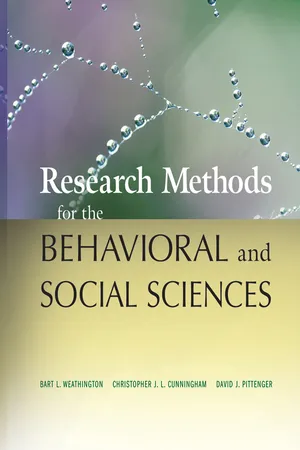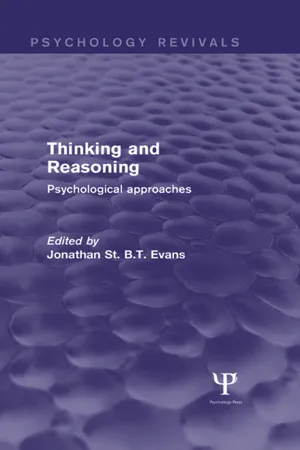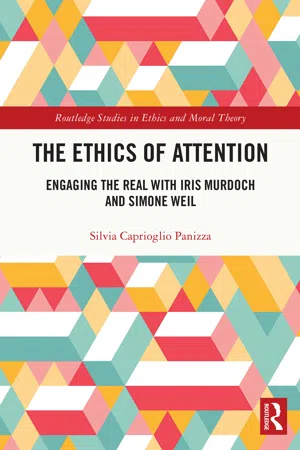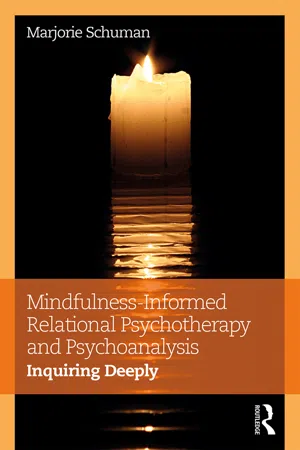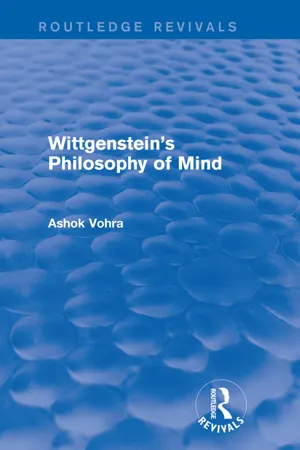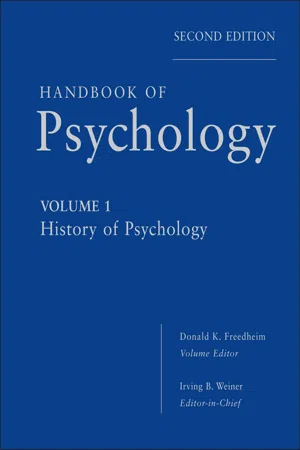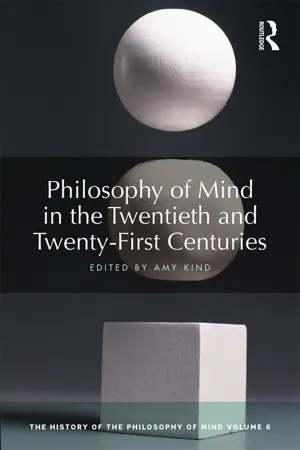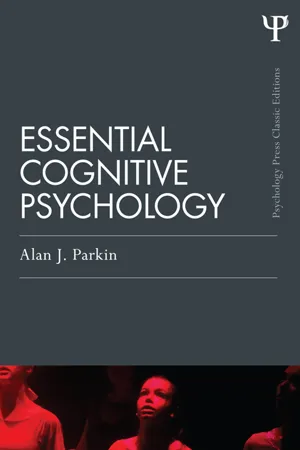Psychology
Introspection
Introspection refers to the process of examining one's own thoughts, feelings, and mental experiences. It involves self-reflection and conscious awareness of one's internal mental processes. In psychology, introspection was a fundamental method used by early psychologists to study and understand the workings of the mind.
Written by Perlego with AI-assistance
Related key terms
Related key terms
1 of 4
Related key terms
1 of 3
12 Key excerpts on "Introspection"
- Bart L. Weathington, Christopher J. L. Cunningham, David J. Pittenger(Authors)
- 2017(Publication Date)
- Wiley(Publisher)
mother? Although Introspection can be revealing, it has several shortcomings. Take a moment to think of a few.Perhaps the most troubling question is, How do we know that the self-report is accurate? When you are asked to introspect about something, will you report everything that occurs to you? Is it possible that thinking of your mother evokes a painful memory that you do not want to share? How complete is your report? Although you may report things of which you are aware, could there be reactions that you did not recognize as important and worthy to share with others? Is it possible that there are unconscious mental processes that you do not directly experience? Psychologists’ use of Introspection troubled Watson because there is no way to verify the accuracy of an introspective report. The problem with Introspection is that only one person can experience or observe your mental events—you. In science, researchers want to examine phenomena that others can see when they use the same procedures.There are other problems with Introspection. To what extent does your Introspection influence the mental events you wish to study? Does thinking about your thinking affect your thinking? Are you confused? Try another thought experiment. Can you read and introspect about the process of reading at the same time? If you are like us, reading for content while introspecting is impossible. As soon as we start examining the process of reading, we are no longer reading. When we read for content, we cannot introspect. What are some other problems with Introspection? Can you ask an infant to introspect? Can children ages 7 or 8 provide objective observations of their mental events? What about a person with depression or schizophrenia; will their Introspections be accurate? If Introspection requires objective and knowledgeable self-analysis, then we cannot use Introspection to study children, people with severe psychological disorders, or animals. Watson (1913) rejected Introspection as a research tool and recommended that psychologists study behavior exclusively. He believed that by focusing on behavior, psychologists could engage in the objective study of all living creatures. For Watson, if you can observe the behavior, then you can conduct scientific research.- eBook - ePub
Thinking and Reasoning (Psychology Revivals)
Psychological Approaches
- Jonathan St. B. T. Evans, Jonathan St. B. T. Evans(Authors)
- 2013(Publication Date)
- Psychology Press(Publisher)
Much current theory is based on viewing man as an information processing system. The study of thinking can be seen as an attempt to understand the software of a very sophisticated computer - the human brain. The issue of Introspection has not died, however. Within cognitive psychology and social psychology, debates continue between those wishing to regard Introspections as one useful source of evidence about mental processes and those wishing to disregard all such reports as unreliable or misleading. This debate has been marked by some recent major theoretical papers, especially those of Nisbett and Wilson (1977) and Ericsson and Simon (1980). The argument involves more than just the use of classical Introspection in the sense of descriptions of mental processes. It concerns the validity of reported strategies and the interpretation of ‘thinking aloud’ protocols collected during problem solving. The interpretation of verbal protocols is thus a matter of major concern in contemporary study of thinking and problem solving and is the focus of BYRNE’s * chapter in the present volume. The problem of Introspection is also, inevitably, addressed in RICHARDSON’s chapter on mental imagery. The remarkable resurgence of interest in the study of mental imagery is one of the reasons why Introspection has remained a focal problem in cognitive psychology. To many, the term ‘imagery’ can only refer to a mental experience of a perception-like character, in the absence of appropriate stimuli. Few modern psychologists are, however, content to use only self-report data, so various attempts have been made to operationalize the definition of imagery and to demonstrate its functional role in cognition (see, for example, Paivio, 1971; Kosslyn, 1981). Particularly interesting is the suggestion (e.g - eBook - ePub
The Ethics of Attention
Engaging the Real with Iris Murdoch and Simone Weil
- Silvia Caprioglio Panizza(Author)
- 2022(Publication Date)
- Routledge(Publisher)
Goldman 2006 : 246). So it seems that what is problematic, and what cannot be done, is not self-knowledge, but self-knowledge through Introspection. Introspection cannot answer the question ‘Am I attending to this story, or failing to?’ because if I am attending, the story is filling my consciousness, and there is no space for questions about what I am doing. As Weil explains:Introspection is a particular psychological state, incompatible with other psychological states.- With thinking about the world …
- With action, at least with voluntary action …
- With a very strong emotion …
Conclusion: since almost everything escapes self-observation, one cannot draw general conclusions from Introspection … By the very fact that one keeps a watch on oneself, one changes; and the change is for the worse since we prevent that which is of greatest value in us from playing its part.(LP 27–28)Introspection is not only incompatible with attention, but it also, Weil writes, ‘defeats its own object’, since all it can reveal is the present act of introspecting, and when applied to past states of mind, it is equally unsuccessful, because one can be mistaken about one’s past inner life, especially in the light of more recent experiences (LP 28). Moreover, one’s states of mind are changed by the act of introspecting, and the change is for the worse, since we are preventing consciousness from being enriched by ‘what is of greatest value in us’—the capacity to be fully impressed by reality.The possibility to preserve self-knowledge, then, needs to go through a direction of consciousness that is not inward, but outward. In what follows I will suggest three general ways in which this can be done (the first way, in turn, will be articulated into three).Knowing ourselves from the outside
The kind of self-knowledge we need for attention is not only about currently ongoing mental states, which is what Introspection claims to offer. It is also about our history, which may be influencing our current perception, about character traits and past or long-standing attitudes and tendencies, about our particular knowledge and lack thereof. And it is also the knowledge of the impact we have on others, as moral agents. - eBook - ePub
Mindfulness-Informed Relational Psychotherapy and Psychoanalysis
Inquiring Deeply
- Marjorie Schuman(Author)
- 2016(Publication Date)
- Routledge(Publisher)
Chapter 8 Reflections on Subjectivity and the Experience of SelfThis chapter has two major goals. The first is to describe subjectivity in a way that clarifies the similarities and differences between Western psychological and Buddhist concepts of self. The second is to define in some detail what psychoanalysis calls “self-reflective function,” explain how and why it is an important therapeutic mechanism of action, and describe the role of self-reflective practices in cultivating it.In general terms, enhancing self-awareness is one of the implicit aims of most forms of psychotherapy. Simply by engaging a therapeutic process (whether psychotherapy, counseling, coaching, “growth work,” or psychoanalysis) attention is focused in a way that makes us more aware of ourselves in some respect(s): what we do, how we think and feel, and how that affects others.In the sections that follow, basic concepts about self will first be presented in order to clarify the use of theoretical language. Self-reflection will be defined and described in a psychoanalytic/theoretical context.1 The psychoanalytic view of subjectivity will be presented, followed by some reflections on subjectivity within a framework of Buddhist ideas. These various strands will be integrated into a discussion of self and self-experience that is compatible both with psychoanalytic work and Buddhist practice. Interwoven throughout the chapter, a clinical example will show how self-reflection can unfold and deepen within the process that I call inquiring deeply.Self: Terms and Basic Concepts The Psychological SelfBeing a “self,” being “someone,” is a given in ordinary experience. We all have some sense of “who we are,” some sense of coherent identity in the core of our being. Thispsychological self - eBook - ePub
- Donald O. Hebb(Author)
- 2014(Publication Date)
- Psychology Press(Publisher)
How it knows itself was a problem, one that reappears in the discussions of later writers, but we can see how the matter must have appeared to Locke. Obviously one knows what one is thinking of, much of the time, and how can that be otherwise than by—somehow—observing those thoughts? We usually regard our information about anything as the result of observing it or being told about it, forgetting how much is inferential even in everyday matters; here there is no question of being told about one’s thoughts, so they must somehow be observed. Also, Locke wrote at a time when certain Cartesian ideas were still being absorbed, concerning mind as an entity cut off from the external world by the intervention of the sensory pathways (ideas that Berkeley would soon develop further). Any mechanism of inference that depended on sensation would be neither obvious nor plausible as a means by which the mind could learn of itself.So it seemed that the mind must know itself directly, and as Ryle (1949) remarked, Locke found a convenient analogy with looking in a mirror. The mind might somehow reflect on itself. This figure of speech became common property in the next hundred years, “reflection” becoming a synonym for thought (as it still is). In such use by the layman the term lost all its special significance. Some more specialized (and more impressive?) word was needed by the philosopher-psychologist, and that need was met by “Introspection,” about 1800. Introspection, looking inward, is still a figure of speech and if anything worse in its effect on psychological thought. It is easier to develop a fantasy about the mind looking inward than of the mind using a looking-glass and furthermore to forget that it is fantasy.In this approach to mind, a fundamental limitation was encountered early. All that could be found, in self-examination, was mental content, with no sign of a self to do the knowing. David Hume’s experience was that he seemed never to find anything but “some particular perception or other.” This limitation on reflection or Introspection became even more restrictive in the work of the empiricists and “British associationists” (not all British) of the 19th century. Instead of perceptions they found only sensations: thus Wundt and his eminent student and contemporary E. B. Titchener of Cornell. It then appeared that mental content is made up entirely of sensations and images (internally arising sensations). Since these were observable it could be supposed that the whole mind lay open to Introspection—and an incredibly shallow, flat and unconvincing mind it was, as it appears in the research of this whole school of thought. - eBook - ePub
- Joshua W. Clegg(Author)
- 2018(Publication Date)
- Routledge(Publisher)
The traditional view of the history of Introspection can be found in introductory textbooks on psychology and in textbooks on the history of psychology. It can also be found in the work of eminent scholars in the field (Brock 1991, 1993; Costall 2006). It is sometimes communicated in the classroom. One of the more curious aspects of human knowledge is that anyone who wants to challenge an accepted view will usually be expected to provide copious evidence in support of that challenge but someone who is expressing an accepted view is usually not required to present any supporting evidence at all. It is partly because of this situation that popular myths are able to survive.For those who do not know it yet, the traditional view of these events is a mythical account. History is a messy affair and does not usually lend itself to being divided up into neat stages. Although it is true that Introspection enjoyed a brief period of popularity in the first decade of the twentieth century, it has never been the dominant approach to psychology at any time in its history. It also did not disappear from the discipline in the years that behaviorism prevailed. Our first task is, therefore, to provide a more accurate account of the history of Introspection in psychology.The Philosophical Background
Introspection no doubt has its origins in traditional religious practices, such as the examination of one’s conscience, but the term did not appear in the English language until the end of the seventeenth century (Danziger 2001; Lyons 1986). It is, of course, derived from the Latin words for “to look within.” The use of the term is closely linked to the rise of empiricism in British philosophy. One of the key figures in this movement, John Locke, famously argued that knowledge is based on experience and he believed that we had two types of experience, experience of an external physical world and experience of an inner mental world. The former was experienced through the traditional senses and the term “inner sense” was frequently used to account for our ability to experience the latter. It should be noted that these views did not extend to Continental Europe where figures like Leibniz and Kant believed that rational enquiry, rather than conscious experience, was the royal road to understanding the mind (Danziger 1980).Introspection was the main method used by British philosophers of mind prior to the establishment of modern psychology but it was not without its critics. The father of positivism, Auguste Comte, had little time for traditional psychology and believed that phrenology would be the key to understanding the human mind. He famously argued that we cannot split ourselves into two so that one part of the mind can engage in complex tasks while the other part observes it engaging in these tasks. He also suggested in an argument that was later to be widely adopted by psychologists, that the results of Introspection were unreliable (Wilson 1991). John Stuart Mill was a follower of Comte in some respects but he was also one of the heirs to the British empiricist tradition and he defended Introspection with what subsequently came to be a standard response to the criticism that Comte had made: He argued that there was no need to split the mind into two; we could engage in complex tasks and then recall what we had done while our memories of them were still fresh. This view is frequently described in the literature as “Introspection as retrospection.” - Ashok Vohra(Author)
- 2014(Publication Date)
- Routledge(Publisher)
Retrospection is a review of past events, or conditions. I shall now try to show that the view that we know the acts and states of our mind by Introspection is untenable. My reasoning is as follows. Firstly, if my knowing a mental act or state – say, my being in pain – involves Introspection, then I must inwardly inspect or perceive (this is what we mean by Introspection) something; for Introspection requires both an object and a subject. It seems natural to answer the question ‘What do I perceive when I have a pain?’ by saying ‘The pain.’ But, this is an absurd answer; it leads us to another question ‘What do I perceive when I perceive a pain?’ Obviously, there is no answer that can be given to such a question. But on the Introspection theory, even in such cases, there must be something that I perceive or introspect. Secondly, on this theory, the observer has to perform two actions at the same time. One to do the action, and the other, to know by Introspection that he is doing it. ‘He would, for example, be both resolving to get up early and concomitantly observing his act of resolving; attending to the programme of rising betimes and perceptually attending to his programme’. 20 But this again leads us to an infinite regression. For, the only answer available on this theory to the question ‘How do you know that you have resolved to get up early in the morning?’ is ‘I know it from Introspection.’ But this answer invites another question: ‘How do you know that you know it from Introspection?’ The only answer available to a theorist is ‘From another act of Introspection.’ This chain shall continue ad infinitum. An Introspection theorist may say here that it is not a synchronous act of attention to both the actions, but is a rapid to and fro switch-over of attention from one act to the other. While saying this he forgets that if Introspection is so described then there is a time lag, however small, between the mental state and its observation- eBook - ePub
The Concept of Mind
60th Anniversary Edition
- Gilbert Ryle(Author)
- 2009(Publication Date)
- Routledge(Publisher)
It was supposed that much as a person may at a particular moment be listening to a flute, savouring a wine, or regarding a waterfall, so he may be ‘regarding’, in a non-optical sense, some current mental state or process of his own. The state or process is being deliberately and attentively scrutinised and so can be listed among the objects of his observation. On the other hand, Introspection is described as being unlike sense observation in important respects. Things looked at, or listened to, are public objects, in principle observable by any suitably placed observer, whereas only the owner of a mental state or process is supposed to be able introspectively to scrutinise it. Sense perception, again, involves the functioning of bodily organs, such as the eyes, the ears, or the tongue, whereas Introspection involves the functioning of no bodily organ. Lastly, sense perception is never exempt from the possibility of dullness or even of illusion, whereas, anyhow according to the bolder theories, a person’s power of observing his mental processes is always perfect; he may not have learned how to exploit his power, or how to arrange or discriminate its findings, but he is immune from any counterparts to deafness, astigmatism, colour-blindness, dazzle or muscae volitantes. Inner perception, on these theories, sets a standard of veridical perception, which sense perception can never emulate. The findings of Introspection are reputed to differ in one way at least from the supposed deliverances of consciousness; Introspection is an attentive operation and one which is only occasionally performed, whereas consciousness is supposed to be a constant element of all mental processes and one of which the revelations do not require to be receipted in special acts of attention - eBook - ePub
- (Author)
- 2012(Publication Date)
- Wiley(Publisher)
By 1905, the functional point of view had become the dominant view in American psychology (Leahey, 1992). For his part, Angell claimed that functionalism could easily contain Calkins's “Self Psychology,” “were it not for her extreme scientific conservatism in refusing to allow the self to have a body, save as a kind of conventional biological ornament” (Angell, 1907, p. 82). Calkins and Titchener did not reject the pursuit of identifying the physiological substrates of mental content and processes but placed that pursuit at a lower priority to the study of mind more directly. Indeed, Calkins extended the use of Introspection to the study of abnormal experiences of the normal self and included the study by comparative means of abnormal individuals (Calkins, 1901, 1919) among the range of topics to be studied in the new psychology. In these psychologies, Introspection continued to serve as a method for the direct examination of conscious experience, but problems arose when introspective reports from different laboratories contradicted each other. Doubts about the capacity of Introspection to serve as a scientific method were brought forcefully into focus by the “imageless thought” controversy.Titchener's psychology proposed that images were the carrier of thoughts, and introspective observations carried out in his laboratory supported his position. Oswald Külpe and his colleagues at the University of Würzburg, however, failed to observe images in their studies of thought processes and concluded that thinking was carried out by “imageless thoughts” (see Humphrey, 1951). How could Introspection, as a method, reconcile incompatible results when conscious experience was private and not open to public inspection? Supporters of Introspection as the primary method of scientific psychology added more instructions in an attempt to improve the method (English, 1921) while others advocated its more limited use among other psychological methods (Angell, 1905; Dodge, 1912). The question of whether introspective analysis could indeed serve as a scientific method producing reliable data was present at the start of psychology's history as a science. Introspective observations were reliable within limits: A wavelength of light at a given frequency was reported to evoke the same color sensation in all observers of normal vision. The question lay in the capability of Introspection to go beyond such limited observations in the search for elements of mind. Meanwhile, other research traditions arose. - eBook - ePub
Philosophy of Mind in the Twentieth and Twenty-First Centuries
The History of the Philosophy of Mind, Volume 6
- Amy Kind, Amy Kind(Authors)
- 2018(Publication Date)
- Routledge(Publisher)
ch 4 ), gives Introspection a key role in analysing experience into its basic components and in discovering the rules of combination in terms of which complex conscious contents of ordinary experience can be explained. In this capacity, the role of Introspection was to overcome the naïve but misleading take on experience, and to discern the real conscious character with its basic sensational structure. In Titchener’s hands, then, introspective investigation of conscious experience is a form of analysis, or, as it was sometimes called ‘reduction’, of experience into its basic sensory components (Titchener 1912c). Külpe and the Würzburgers endorsed a rather different picture of conscious experience. Specifically, they held that, in addition to sensory aspects, conscious experiences included other fundamental aspects, in the form of mental activity. The latter could not be analysed into combinations of the former. This basic outlook drew on Brentano’s act psychology and Husserl’s phenomenological approach to investigating experience. The Würzburg emphasis on investigating conscious thinking and activity in experience derived from these very different interests.Both sides of the debate practiced systematic Introspection, however. Yet systematic Introspection presented several methodological problems (some old, some new) none of which were particularly hidden from practitioners. Central use of immediate retrospection meant that the concern about memory as a potential source of distortions and gaps resurfaced. The reliance on verbal articulation and report of qualitative data about subjects’ conscious experience introduced worries about scientific validity of the data, given the inability to independently check for the presence of the experiences in question. In addition, the experiments of systematic Introspection, with their active involvement of the experimenter, have a strong demand character, which presents its own danger for infecting the data collected (Müller 1911). Part of the explanation for why systematic Introspection was attractive to its proponents despite all these known problems is the pervasive influence of phenomenalism in science and philosophy at that time.17 - eBook - ePub
- Alan J. Parkin(Author)
- 2013(Publication Date)
- Psychology Press(Publisher)
1 THE ORIGINS OF COGNITIVE PSYCHOLOGY The ancient theory of eidola, which supposed that faint copies of objects can enter the mind directly, must be rejected. Whatever we know about reality has been mediated, not only by the organs of sense but by complex systems that interpret and reinterpret sensory information. Ulric Neisser, Cognitive Psychology, 1967 My first aim is to explain why cognitive psychology came about and how it arose from earlier attempts to explain the human mind. In taking this perspective one could go back a long way. Ancient Greek philosophers, for example, had many ideas about the workings of the mind and throughout the history of philosophy there have been concerns about issues that we would now see as the domain of cognitive psychology. However, an account of this nature would be a book in itself and I will confine myself to the last 100 years or so. Towards the end of the 19th century psychology was dominated by an approach known as Introspectionism. The basis of Introspectionism was to study mental processes via a method of subjective self-examination. In a typical experiment subjects would carry out a mental act and then report on their inner experiences. A common topic was the nature of mental images ; this refers to pictures we all experience in our mind’s eye when we are told to imagine something. Images were thought to be the basis of memory so there was great interest in trying to elucidate the properties of images more clearly. Experiments were therefore conducted in which ‘observers’ formed mental images and then answered a series of questions about what they held in their mind. One question, for example, might concern the clarity of the image at different points and another might concern the intensity of colour. By collecting a sufficient number of these observations it was hoped that some consensus could be reached about the structural properties of mental images (e.g - eBook - ePub
Psychology's Territories
Historical and Contemporary Perspectives From Different Disciplines
- Mitchell Ash, Thomas Sturm(Authors)
- 2007(Publication Date)
- Psychology Press(Publisher)
Finally, the chapters by Jill Morawski (chap. 6, this volume), Kenneth Gergen (chap. 7, this volume), and Thomas Sturm (chap. 8, this volume) focus on the concept of self. General historians have recently taken up this topic by asking whether different political regimes implicitly posit, or in some cases even try to create, different kinds of “selves,” meaning citizens as objects of political power relations (see, for example, Egighian, 2004). Jill Morawski approaches the topic by investigating the history of the ways in which psychologists talked about themselves as researchers, and about their subjects as producers of material for scientific treatment, during the early history of academic psychology in the United States. As Morawski argues, by introducing techniques such as quantification, aggregate statistical methods, and nominal classification of subjects, psychologists transformed the objects of their analysis, re placing particularities about subjects, their sensitivities and subjectivities with subjects rendered anonymous and purportedly passive actors, their thoughts and behaviors represented solely through experimenters’ terms or numbers. In parallel to this process experimenters emerged who no longer themselves generated objects of analysis or engaged in self-reflection (Introspection) but, rather, came to regard themselves largely as scientific practitioners of objective research techniques. Thus, psychologists dealt with the problematic relations between scientific and everyday psychology by constructing two kinds of self-concepts that were in tension with one another. Strack and Schwarz (chap. 10, this volume) consider the methodological issues involved here in Part II of this volume, with particular reference to the use of questioning in research. Morawski places this complex transformation of self concepts in the context of changing conditions of personhood and identity in American culture during the early 20th century.Kenneth Gergen (chapter 7 , this volume) shows that the cyclical interaction of everyday and academic psychology has worked particularly prominently in the case of so called “mental deficits.” As psychological concepts like “depression” have been used more frequently in ordinary life, Gergen argues, people have come to been seen—and to see them selves—more often and more easily as mentally ill. As they seek professional help more frequently, psychology reacts to this increasing demand, and the cycle continues. Gergen explains such cycles by arguing that psychological phenomena are socially constructed in any case, and that such constructions depend in turn on intellectual and financial interests. However, though he calls the process “colonization,” he acknowledges that it need not result from deliberate strategies by psychologists in order to be effective.Thomas Sturm (chap. 8, this volume) argues that there is a conceptual fragmentation in talk about “the self” between psychologists and philosophers. One way to resolve it is to compare philosophical and psychological perspectives on phenomena such as self-knowledge or self-control, in order to clarify how the self, or rather talk about the self, figures in such phenomena. Sturm applies this approach to self-deception. One could imagine a disciplinary division of labor between philosophical analysis of the everyday concept of self-deception on the one hand and empirical psychological studies of the origins and functions of self-deception on the other hand, but such a convenient division has problems of its own. As Sturm argues, it is not possible to establish a single correct concept of self deception with philosophical analysis alone; indeed, some philosophers have seriously doubted that such a thing as self-deception is logically possible. Nonetheless, psychologists and philosophers still have areas for fruitful discussion, for example the question of the rationality or irrationality of the phenomenon.
Index pages curate the most relevant extracts from our library of academic textbooks. They’ve been created using an in-house natural language model (NLM), each adding context and meaning to key research topics.
Explore more topic indexes
Explore more topic indexes
1 of 6
Explore more topic indexes
1 of 4
